
We’re finally here! Batman’s popularity has earned him his own dedicated magazine, a quarterly with its first issue released in Spring 1940. Rather than the standard single 12 page story in Detective Comics, the quarterly contains four 12 pagers. Holy page count! And #1 is a real, dare I say it, whizzbang. It contains the debuts of The Joker and “The Cat”, along with the return of Hugo Strange.
The first Batman is nonetheless very much a study in contradictions and reflects the still-forming identity and personality of the character. As much as I goof on them, the pre-Robin issues of Detective Comics really are something special to me. They have a fundamentally lonely quality to them and flashes of a deep nightside atmosphere, even a grimness to them that I find endlessly fascinating. Batman is himself quieter, more serious, more solitary. They are flush with fullmoons and eerie skies, moments of being transfixed in night.
Robin brings a welcome levity, but it would be wrong to say nothing is lost with his addition. And this early version, though extremely rough around the edges, is compelling to me for that deep in the night quality. It will be a long time before that Batman is fully revisited in the comics. Though of course, the solitary Batman is, post Frank Miller, by the far the most familiar to most people today, if we judge by Batman’s portrayals in film, at least, from which Robin has been absent for several decades.
Whatever this dark quality is, it is present almost more in the gestalt impression of the first dozen or so issues than any particular moment. It’s in Bruce’s abstract geometric designs still in black (not fully blue), the repeated images of him emerging from the corner of panels like a ghost, the woodcut like art with its dense hatching, the amateur quality of the art, its willingness to pause wordlessly on certain images.
Even the characteristic “grumpy kitty” version of Batman starts to fade after issue #38. Part of the appeal of grumpy kitty Batman is his communication by expression alone and in the stylization of his early design. This panel sums up this early version for me. When I think of Golden Age Batman, it is this specific image that jumps most readily to my mind. This is my most beloved Batman.

As we have seen, Batman has started quipping consistently and he talks aloud to himself more frequently. This necessarily decreases a bit of the mysterious opacity of early Batman and makes him feel more like a jolly prankster than a tortured vigilante. Charming cat-grumpiness has been replaced by a dad-like sass. By the end of The Cat story, the character is almost completely unrecognizable from what came before up to this point. That story is strangely light with bewildering fourth wall breaks and a sitcom style ending. But you will find it sat up against Batman’s most overtly brutal behavior so far in The Monster Men, and a post-Robin continuation of the darker side of Batman in The Joker stories. The Cat feels much more like 60s camp Batman, while The Joker stories retain aspects of the old school 30s pulp darkness.
On top of that, the art varies wildly throughout the issue. At times I felt like I was reading it in a gas leak with its strange figures and distorted and melting faces. (Admittedly, this could be related to the recolored versions I’m reading on DC Infinite.) I haven’t analyzed this statistically, but the visual density of many panels seems to have decreased as well. This issue feels much more visually sparse than ever before, with more backgroundless panels filled with just a single color. Compare the panels below, for example:
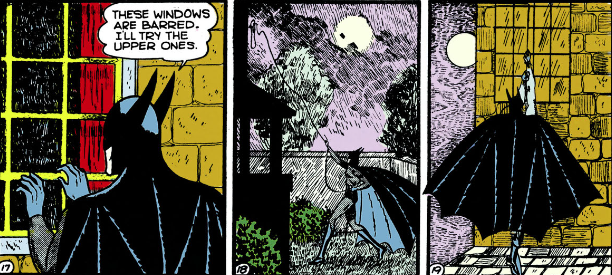

This can feel dislocating, as if the action sometimes floats in no space, and also makes the overall visual brighter and less “gothic”. I have to imagine this was a consequence of the increased volume of art demanded, but the impact feels obvious. Coupled with the increased volume of text, Batman #1 feels somehow fuller and emptier, less likely to pause for atmospheric effect and less likely to let an image speak for itself. (You can also note the development of Batman’s costume in a single year: gone are the long pointed ears, tinier gloves, geometric pointed and all black cape.)
All this is to say nothing of some of the truly unhinged choices made in this issue, which must be experienced firsthand, which I’ll comment on in my notes to the individual stories as they’ll deserve their own highlight.

Story 1: “THE JOKER”
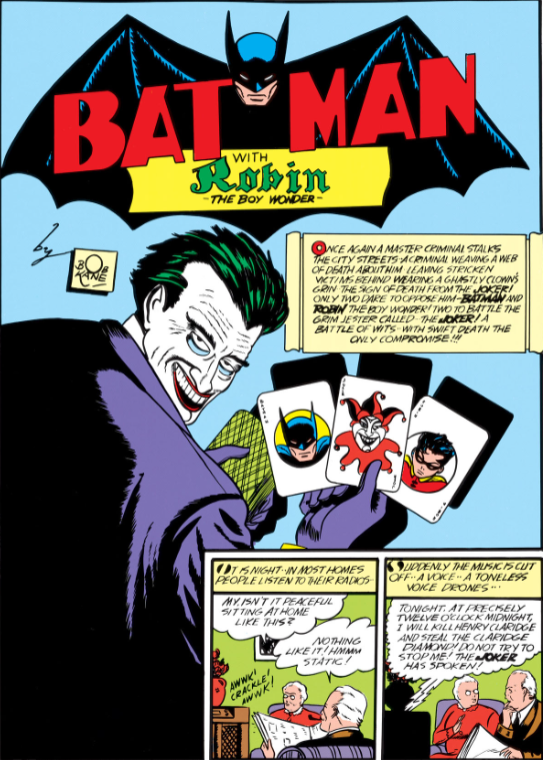
The first appearance of The Joker in comics history and he’s a super upsetting looking dude! I think it’s possible he might be bad news!
Part of this story’s joy lies in reading the various descriptions of The Joker, written in prose as purple as The Joker’s iconic suit:
A criminal weaving a web of death about him leaving stricken victims behind wearing a ghastly clown’s grin – the sign of death from THE JOKER!
A toneless voice drones…
In this original incarnation, The Joker is obsessed both with murder and with fancy gems. His M.O. is to announce, over the radio somehow, that he will murder someone rich or famous and steal their coolest gem.

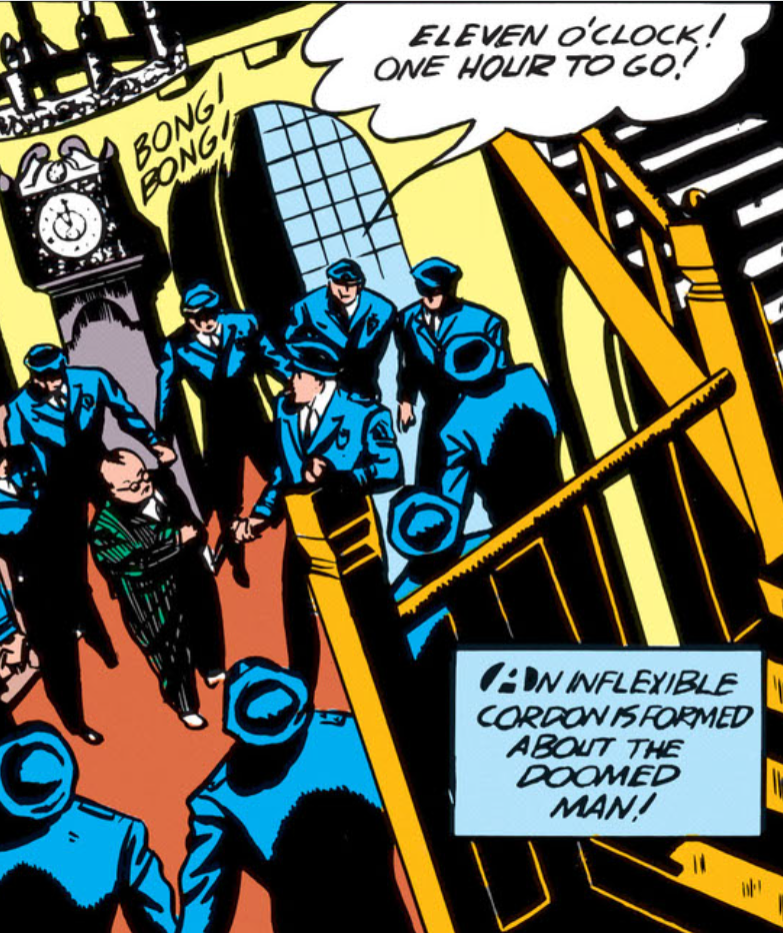
With adequate warning, the police move to make it impossible for anyone to reach the doomed man. But then, as the hour is struck!


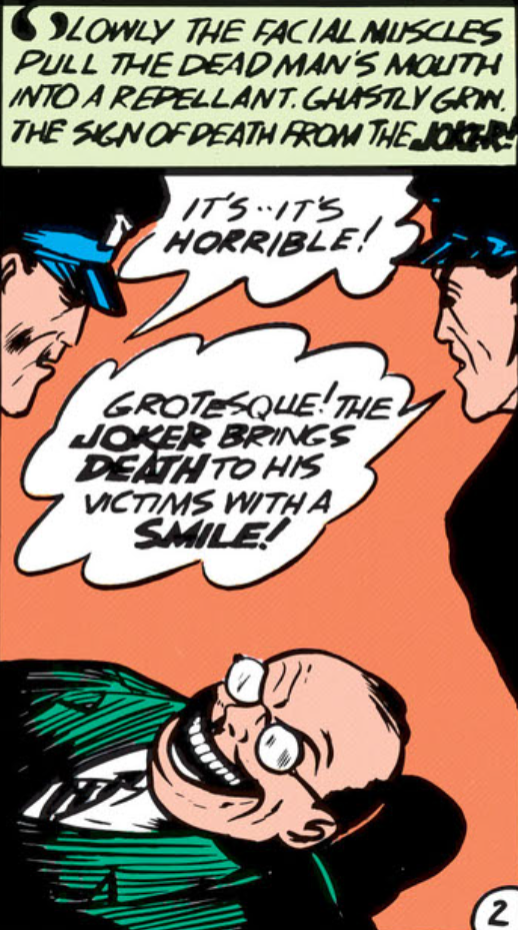
The man chokes to death and dies with this horrible grin on his face, which honestly is maybe the genuinely creepiest thing in any Bat-book up to this point. This is straight up like that early closet scene in the American remake of The Ring.
We then are shown The Joker in his lair which prominently features a tiger skin rug?
A man with a changeless, mask-like face… but for the eyes… burning, hate-filled eyes!


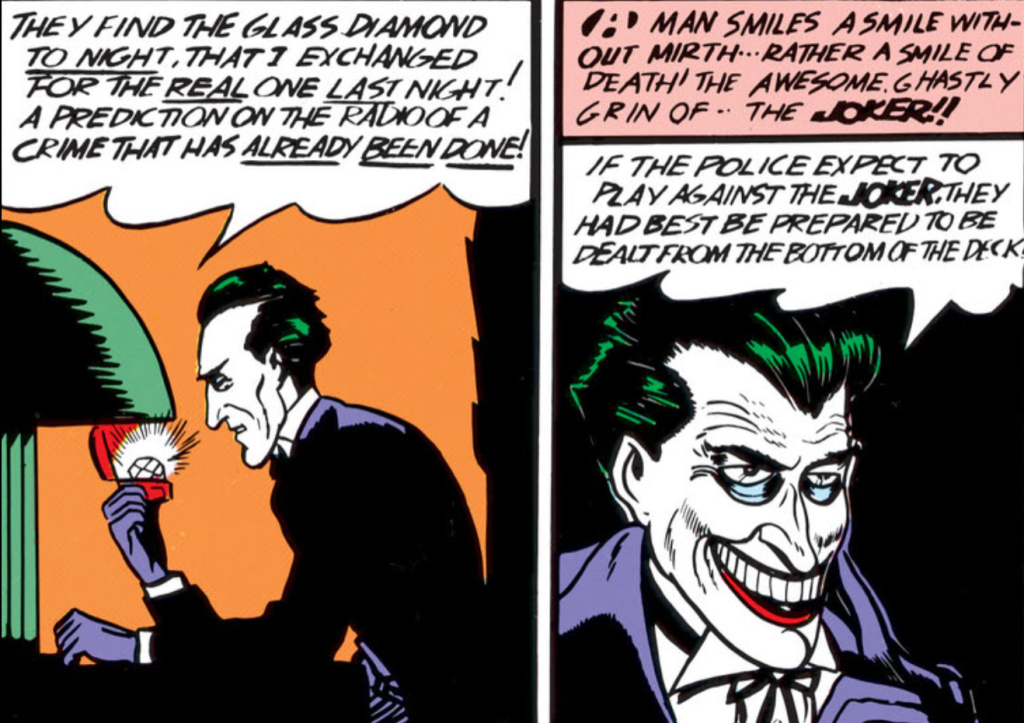
IMO, there’s a lot going on here. First of all and most importantly, in that second to last panel, The Joker looks exactly like a whiskerless Abraham Lincoln. Second, The Joker’s teeth don’t feel human and my intuition is that he has too many. Third, we never learn in this original issue how or why The Joker exists. He simply pops into the universe fully formed. And while there are decades of different takes on his character, OG Joker does feel brimming with a barely contained violence where many modern incarnations give him a kind of poised glee in the midst of chaos.
These panels also exemplify the subtle shift to a less visually dense style (after the establishing ‘shot,’ the backgrounds become single colors with mostly silhouetted decoration) that nonetheless contains a lot of text.

One of my favorite parts of this issue is Batman being like, “shut up, Dick. The time isn’t ripe” with absolutely no further explanation for why he isn’t doing anything. However, this is in the fine sub-tradition of Batman-going-“Hmmm”-ponderously-while-he-smokes. While Bruce enjoys his tobaccky….

Another man is marked for death!

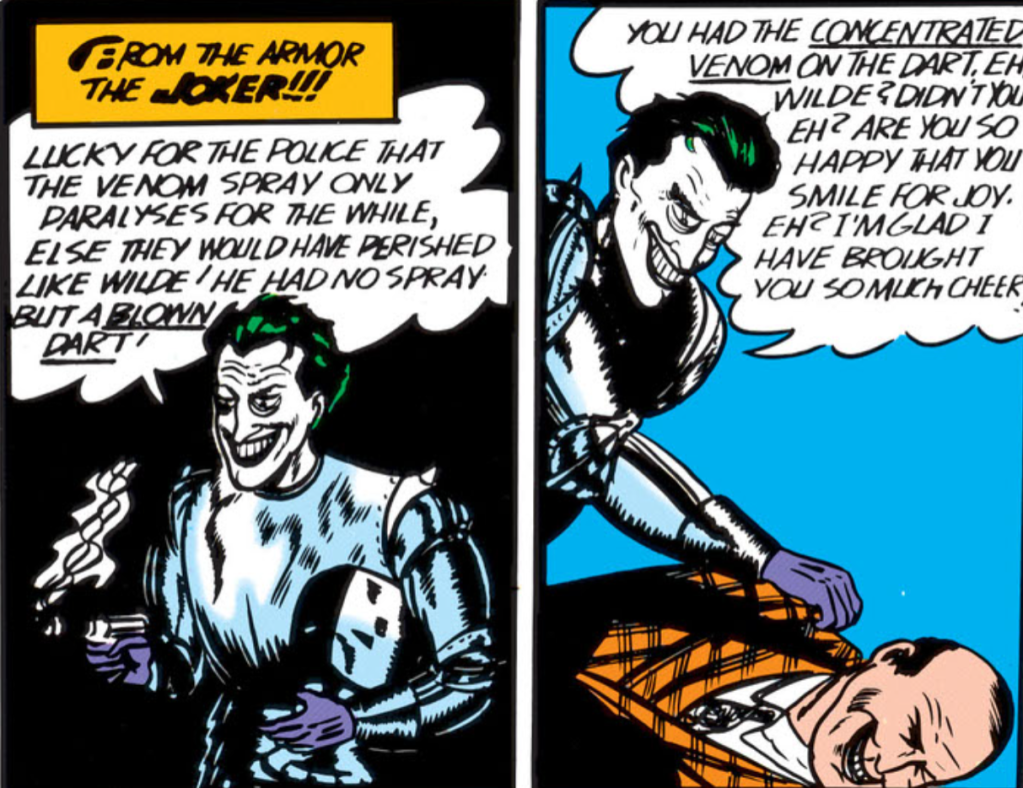
The Joker was absolutely hiding in a suit of armor and dart-gunned this guy to death with (in its first mention) Joker Venom.

And then, arguably, the most iconic image of the original joker. The same one referenced, for example, in the character’s first big scene in Burton’s 1989 Batman:
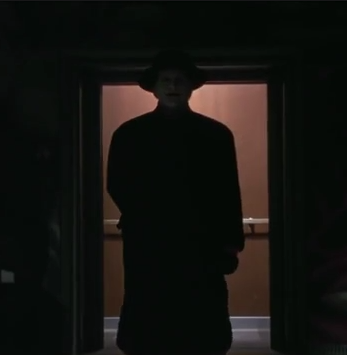
After letting another murder happen, Bruce arbitrarily decides “the time is ripe” after he hears some news over the “grapevine,” which I’m assuming he patronizingly spoke with the indicated quotation marks.
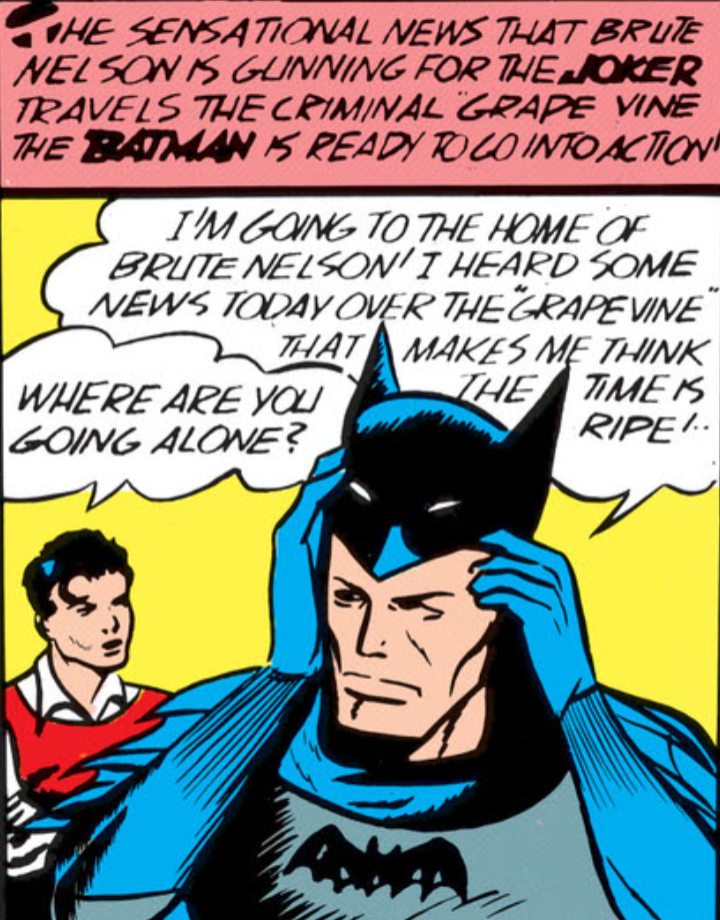
The Joker has gotten in hot with the mob, angry that he’s horning in on their schtick. So, as he does, The Joker gets proactive and visits the boss gunning for him.
Suddenly a droning deadly voice – a funereal face… with eyes radiating hate
These descriptions are so cool, dang. The captions always mention the droning, monotone quality of his speech, which makes me imagine him less like Mark Hamill and more like Andrew Eldritch.
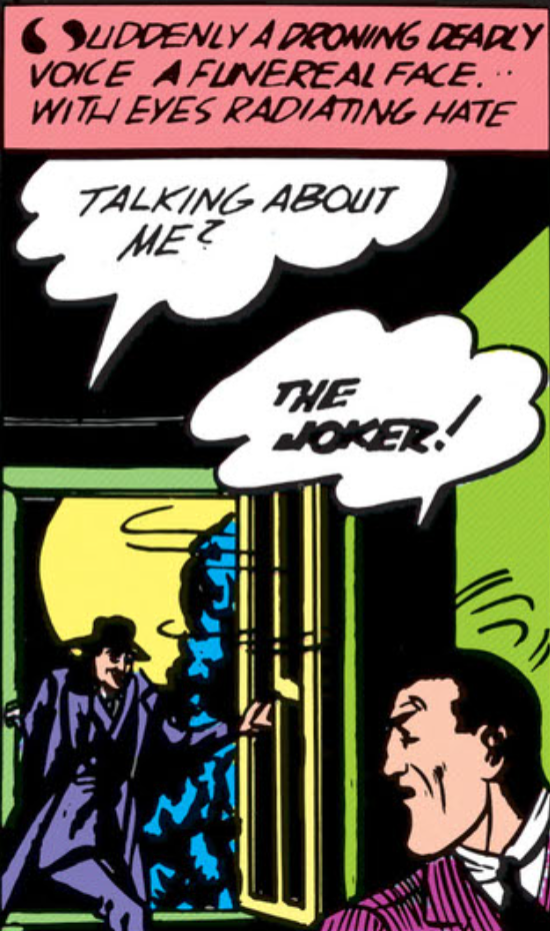
Batman is such a mess. He shows up, but he’s too loud and he alerts all the guards. The panel even includes Batman going, “Ah fuck.”
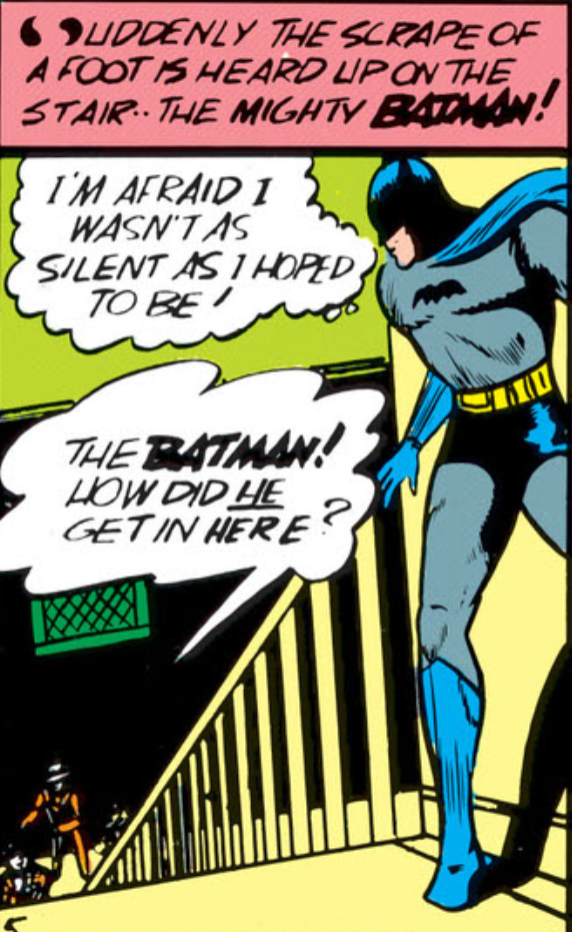

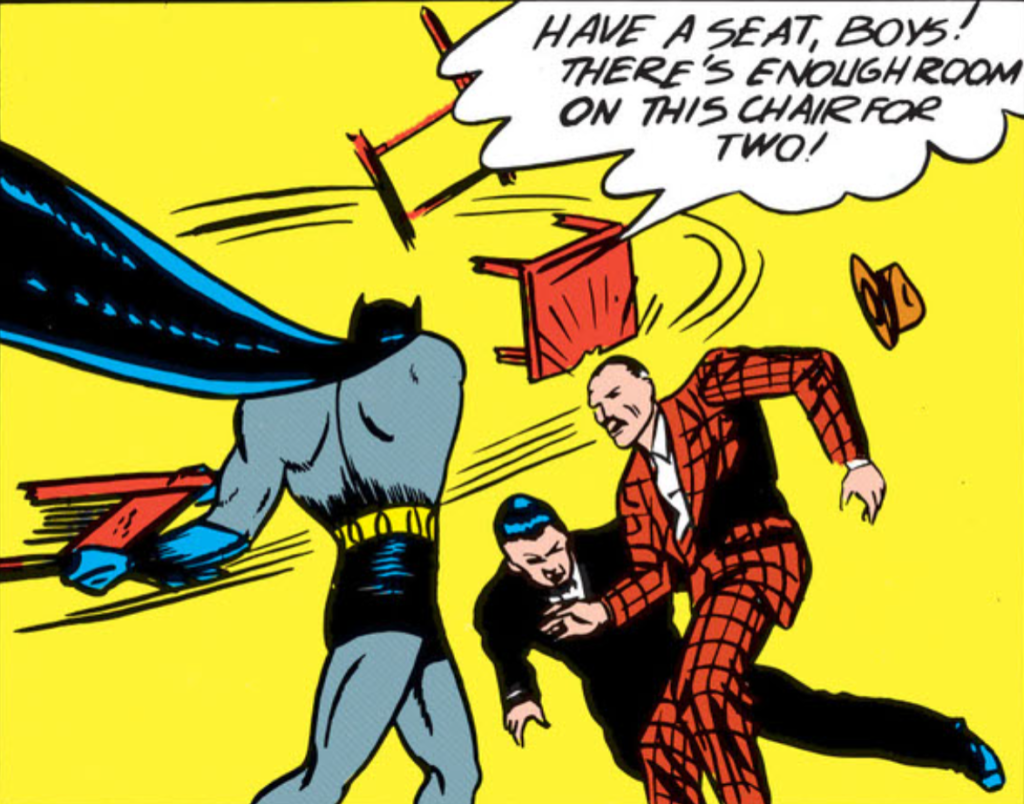
He then starts quipping again in a way that really makes me think he’s not taking any of this seriously.
But when The Joker guns down Brute and flees while making the exact same kind of snarky comment that Bruce is making, this juxtaposition becomes suddenly loaded. We’re seeing this Batman’s casual, almost joyful violence suddenly mirrored in a villain with the same attitude but much less compunction about killing.
So, right from his original appearance, The Joker functions as a kind of mirror image of Batman, giving the book its first, unexpected, mythic-psychological dimension and implicit interrogation of its hero. How different is Batman from The Joker (especially keeping in mind that this early Batman has killed someone or let someone die in most issues)? Is it merely a difference of degree? Where did he come from? His originlessness is actually one of his creepiest components. It’s like reflections of Batman congeal and take shape in Gotham’s shadows.

The Joker speeds away in his car and Batman pursues, delivering by far his best-worst quip so far. An absolute all-timer:
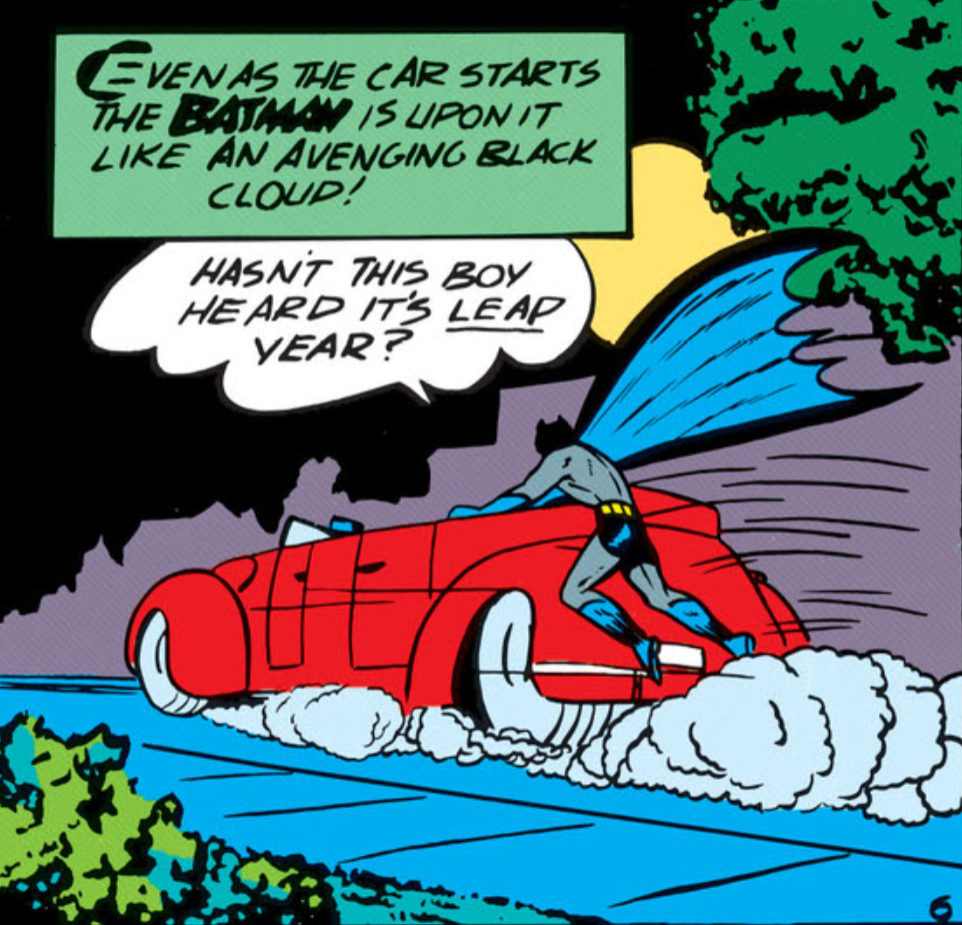
We then get this panel, which is maybe the most overt example of how aesthetically stark the book can get. This could be a feature or a bug depending on your preferences though!
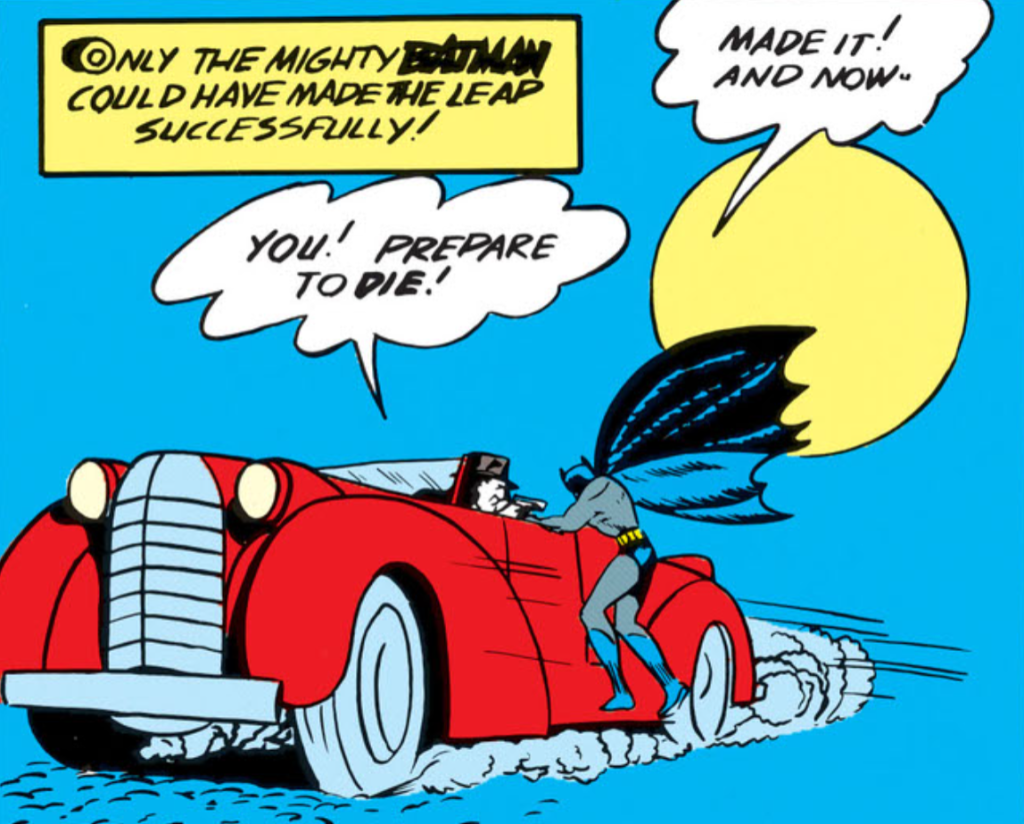
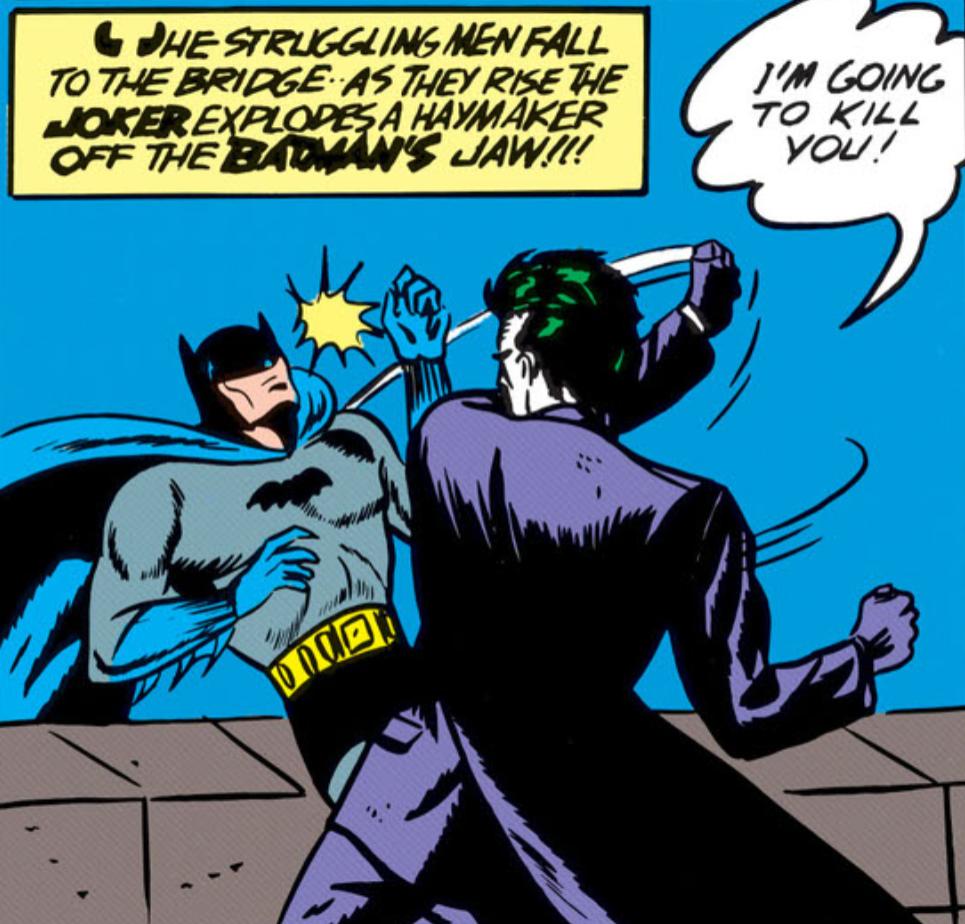
The Joker spends most of the second half of the issue in an increasingly murderous rage, frequently shouting, “I’LL KILL YOU!” And he bests Bruce in single combat, which may be the first time someone has just straight up beat the shit out of Batman without sneakily blackjacking him from behind.

Bruce crawls out of the river, expounding on the same theme, with some art that has a little of that old Bob Kane can’t really draw that well charm.
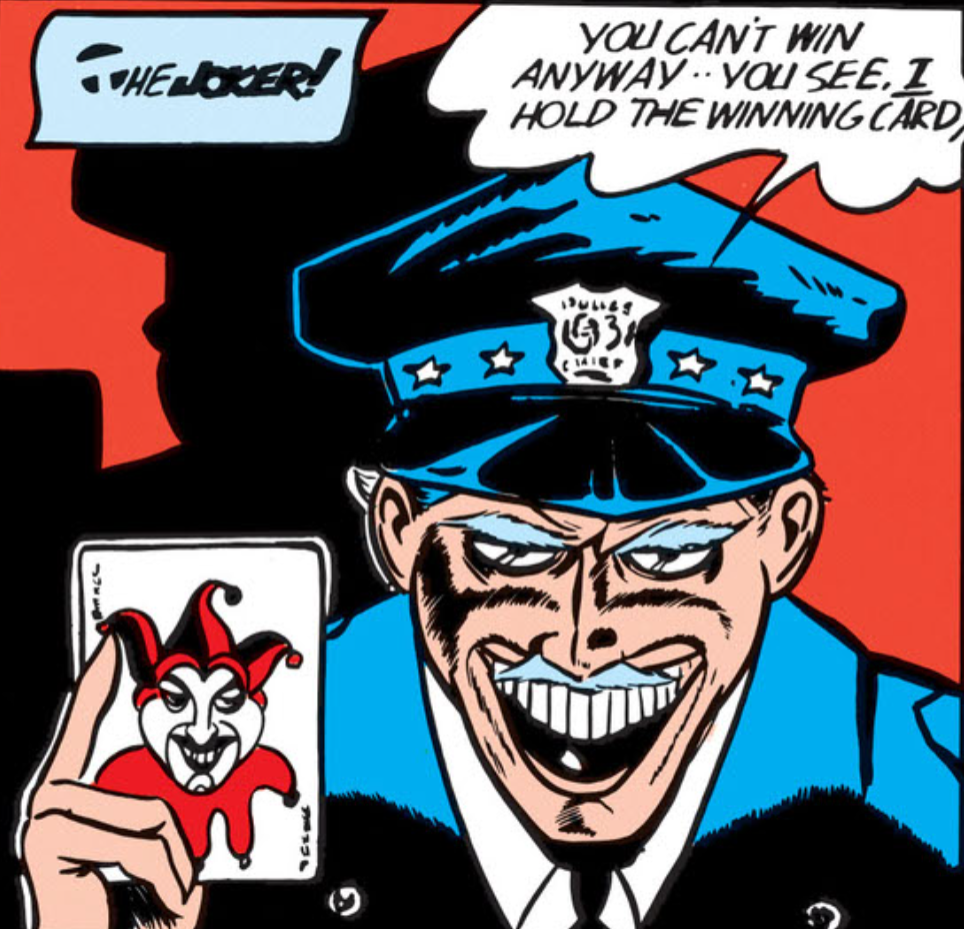
Cut to The Joker’s third murder. This time he is somehow posing as the police officer in charge of watching the doomed man. And we get this horrifying image.
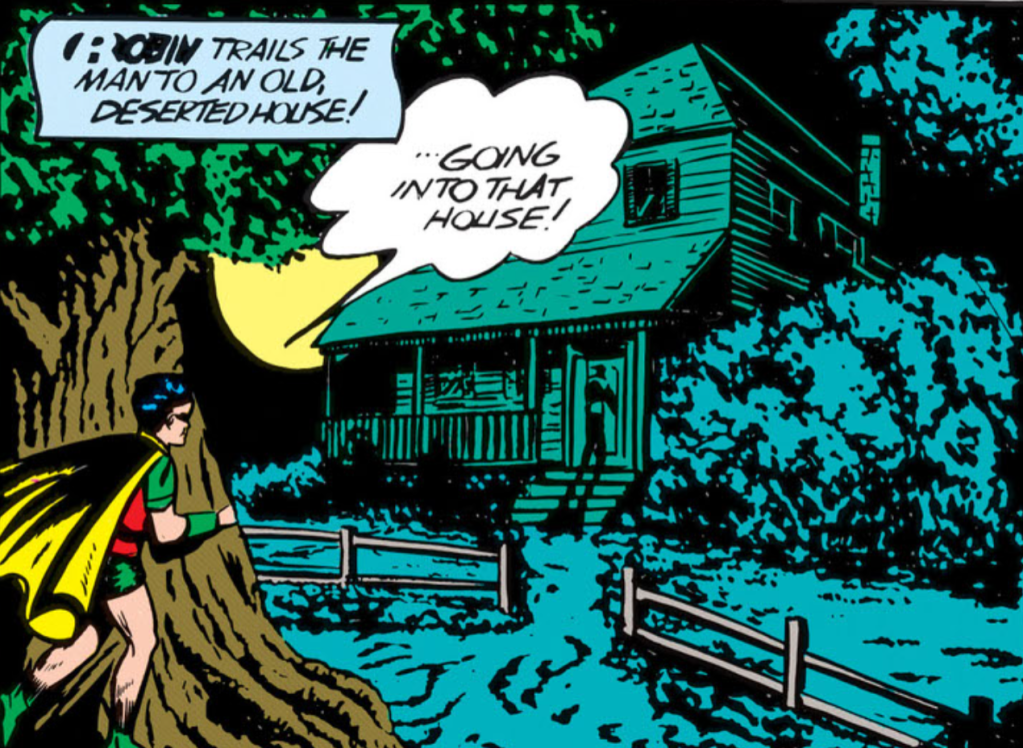
I should not get you twisted in suggesting this issue’s aesthetic emptiness. We are still treated to gorgeous panels like this, as Robin follows The Joker to his little house, where is he promptly blackjacked.
Some traditions MUST BE KEPT.
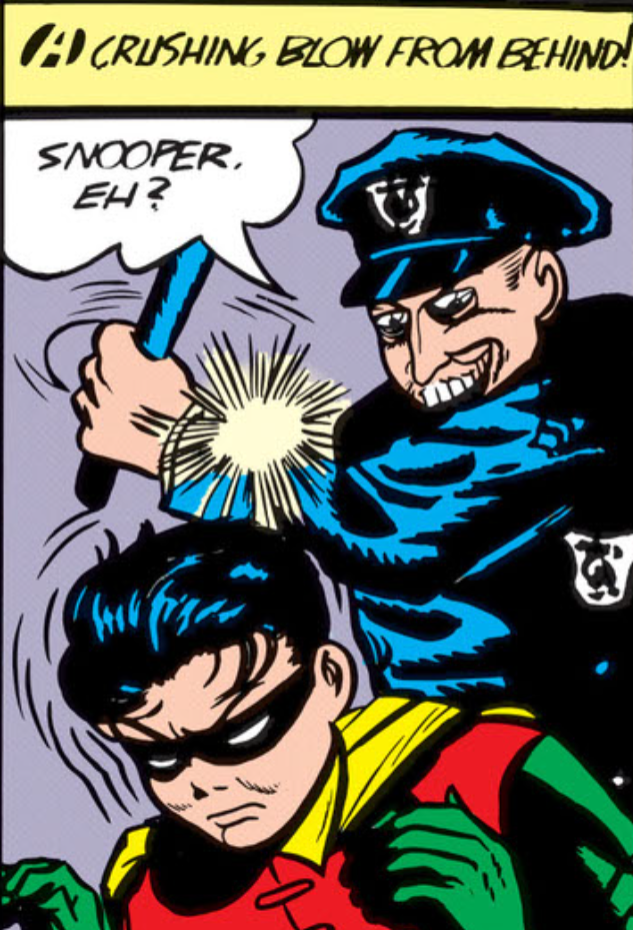
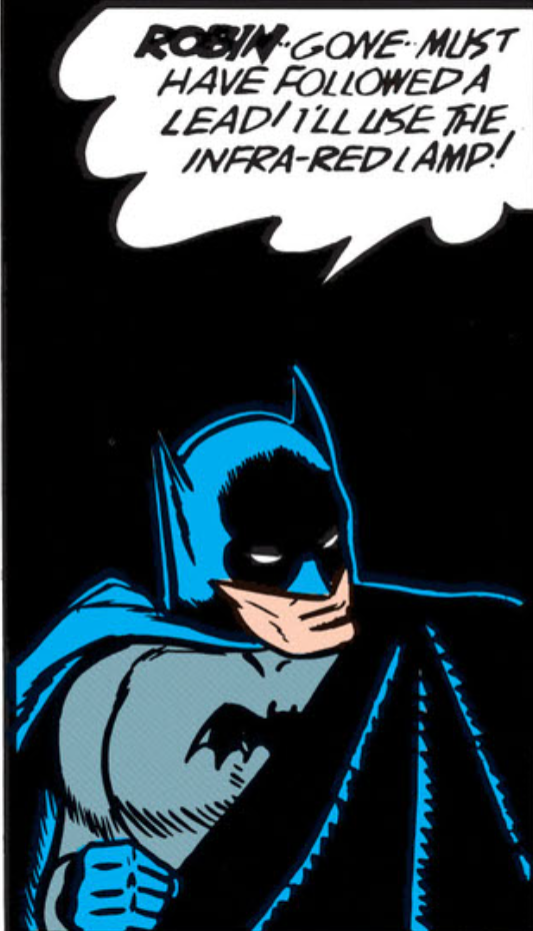
GRUMPY KITTY BATMAN RETURNS!
These fews pages really deliver the 30s Batman goods: creepy house, head trauma, and…

CUTE CORNER GHOST BATMAN!
Debuting his new gizmo: an infrared flashlight that shows footprints from the chemicals he puts on his and Robin’s boots? Okay, sure!
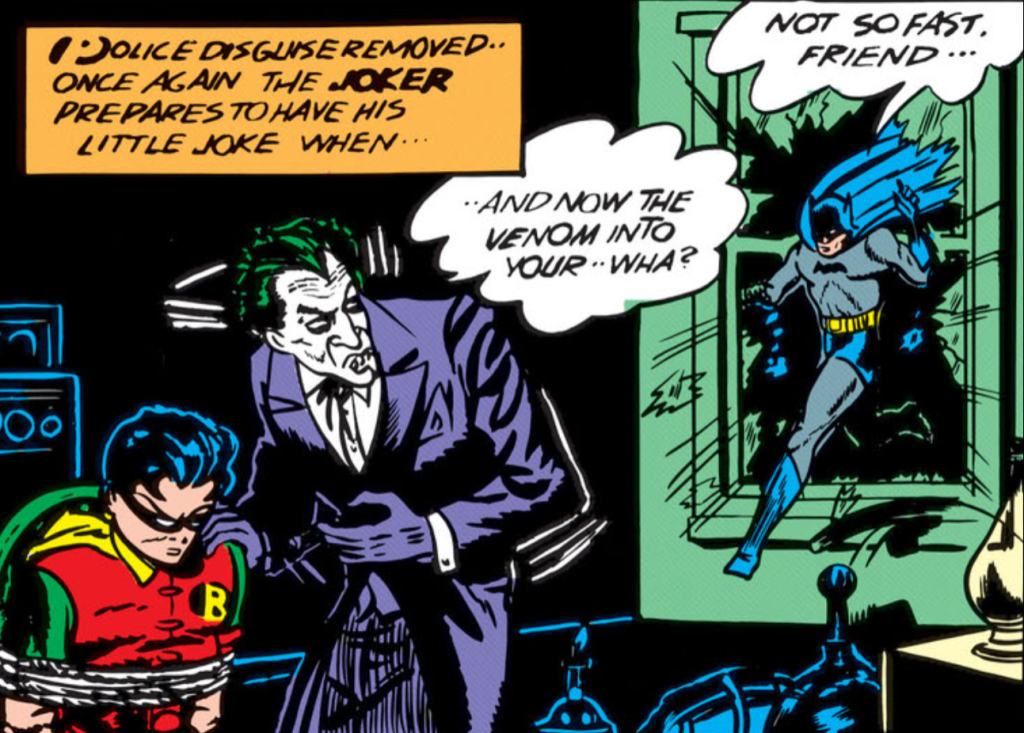
Right from his first appearance, The Joker is seconds away from murdering a child. Or as the book calls it, “having his little joke.” Jesus. Batman drama queens his way into the room. Robin seriously just went in the front door, but okay, Batman. I guess to be fair to Batman, going in the front door did lead directly to a blackjacking.
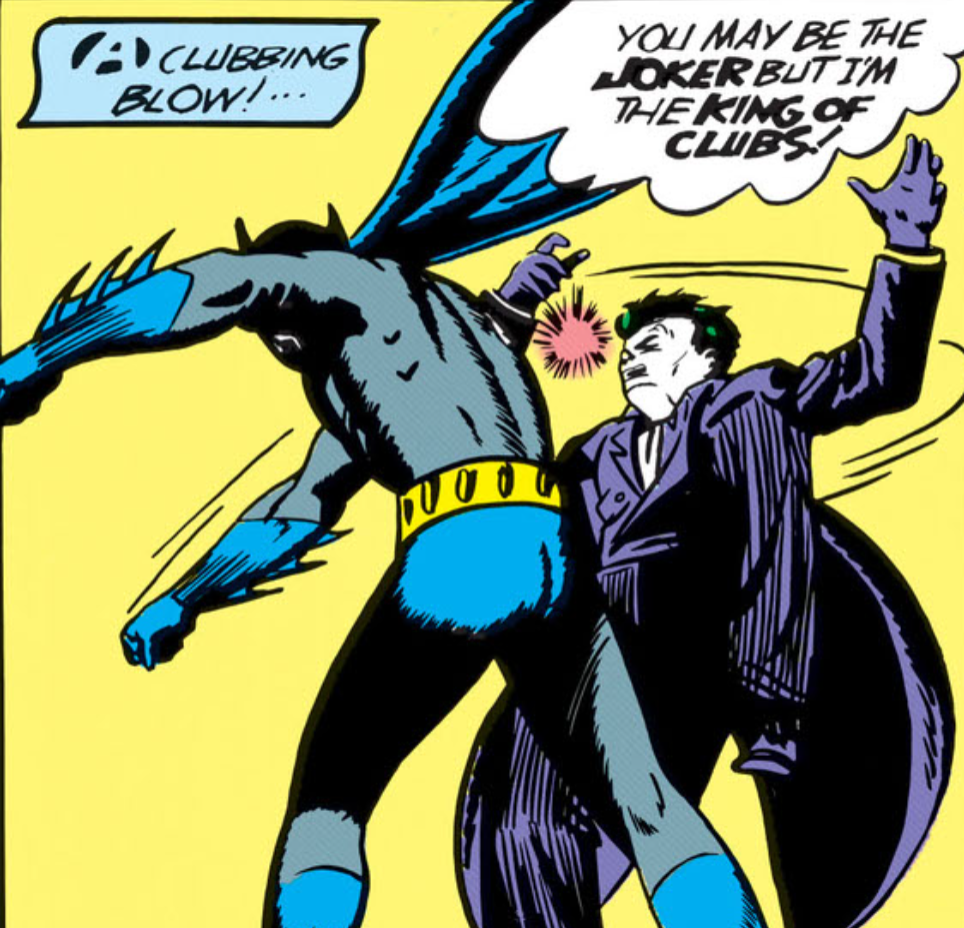
Batman actually hits with a good quip this time as he punches out Mistah J. This sends The Joker flying into a table full of chemicals which end up gassing the room. The Joker is immune to his own poison because he injects himself with antidote.
Batman makes this amazing face.
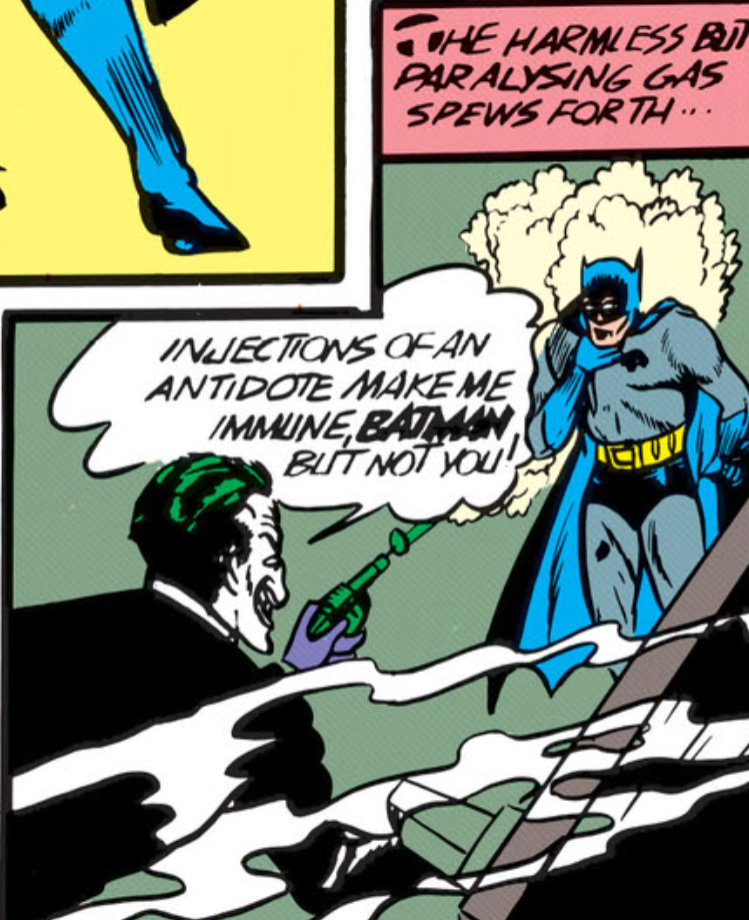
The Batman Who Laughs started all the way back here! Pretty freaky to be quite honest with you!

How will Batman get out of it you wonder??? What incredible act of intellect, of will, or derring-do will save him?

I don’t know he just gets better.
Then we get this iconic running at the camera panel, famous from the opening of the 60s TV show.

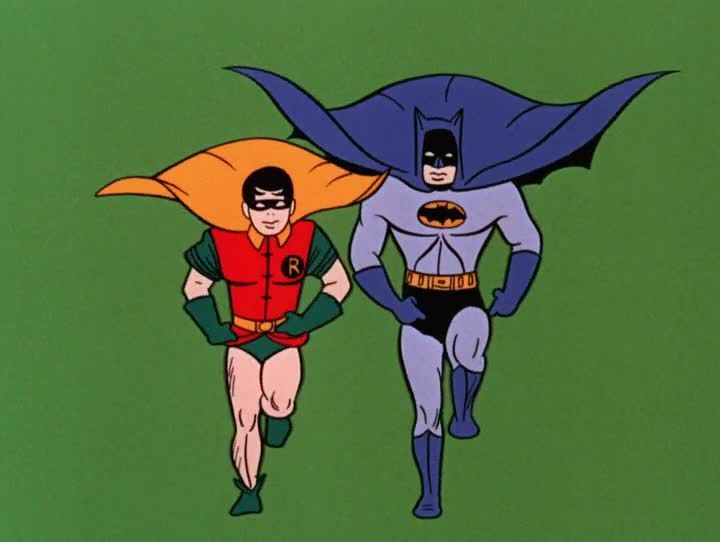
The duo chase The Joker to some rooftops, as he opens fire on Batman while screaming again about killing him.
Also, no shade to Bill Finger, but a real: tell me you don’t know how a bullet-proof vest works without telling me you don’t know how a bullet-proof vest works. Or maybe Batman is just that FRICKING tough.
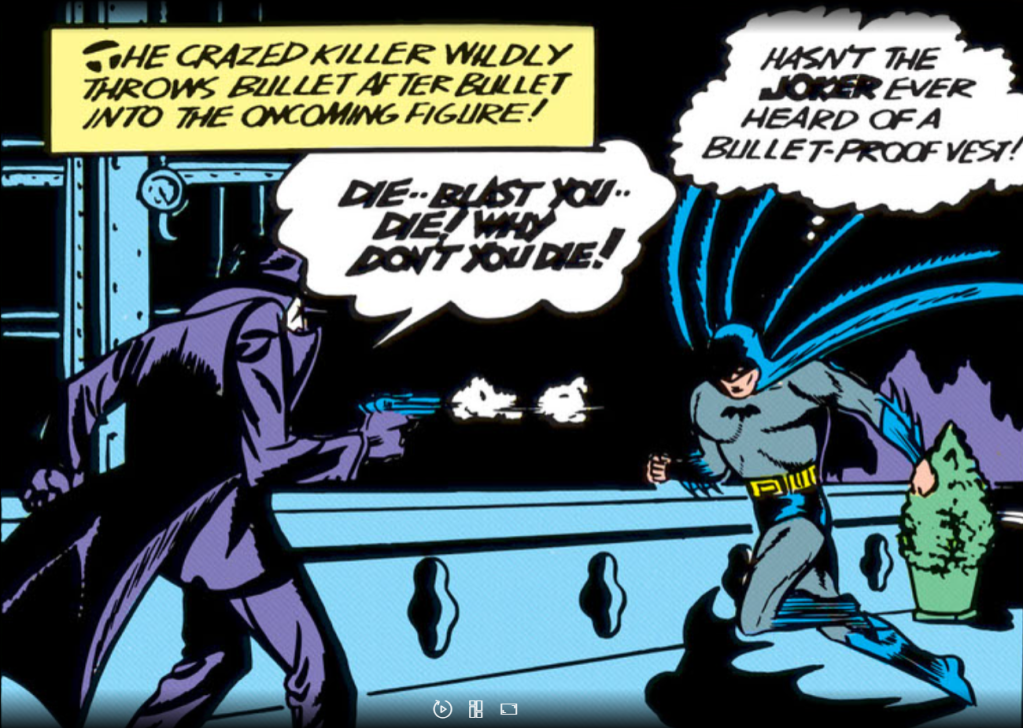


The Joker has a completely manic frenzied violence to him that seethes. It makes the laughter seem more like an affectation and leans into depicting what the captions have described: someone overflowing with rage and hatred.
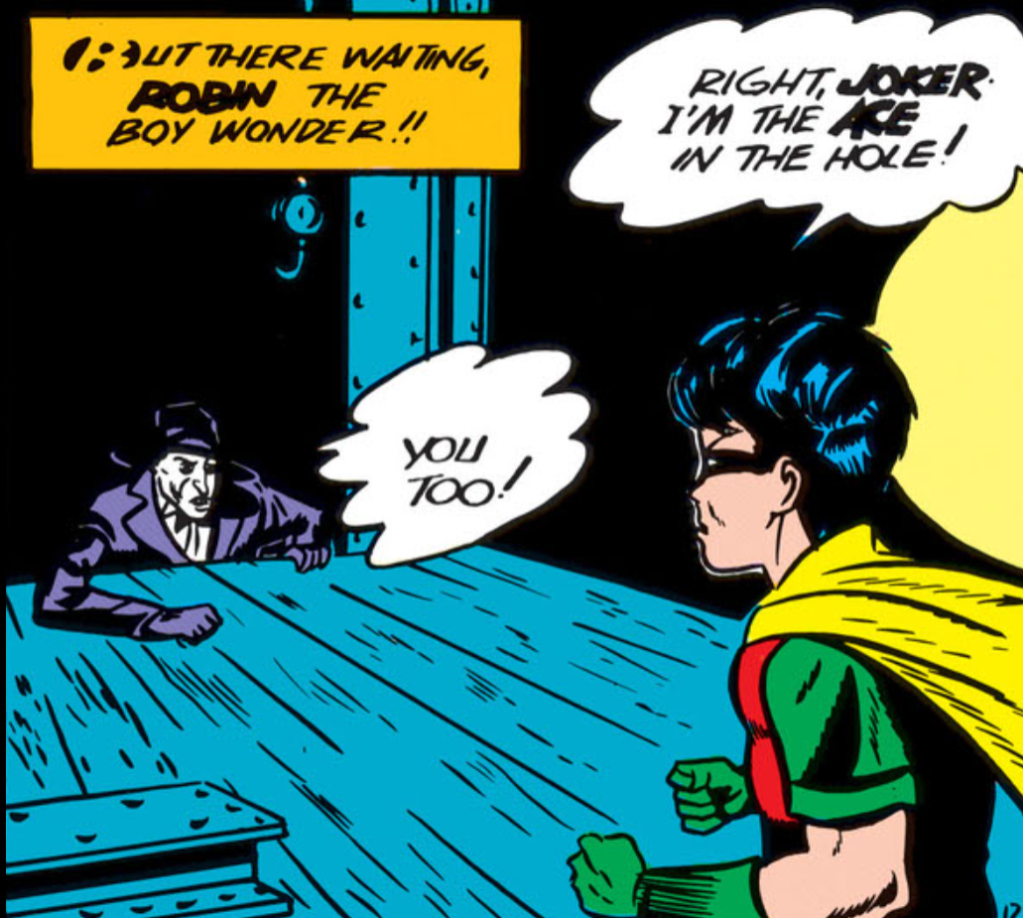
Robin gets his own card-related quip in this one too. And honestly, maybe it’s because Bruce never shuts up, but I’m actually starting to like Robin more than Batman. I love this spunky little nerd. Plus, he gives the book Nancy Drew/Hardy Boys energy, which is close to my heart.
Then in a significant moment, Batman hauls The Joker back to safety. While he had let Hugo Strange live in an earlier issue, this goes the farthest towards his eventual “no killing” rule and reflects the man-encounters-his-shadow metaphysic that will deepen in years to come.
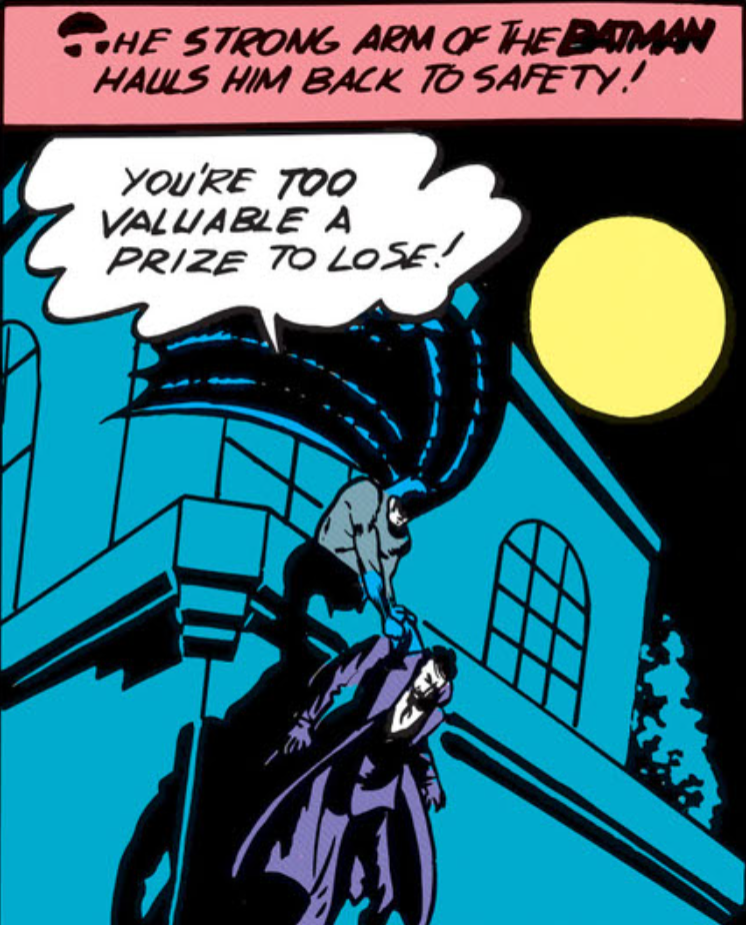
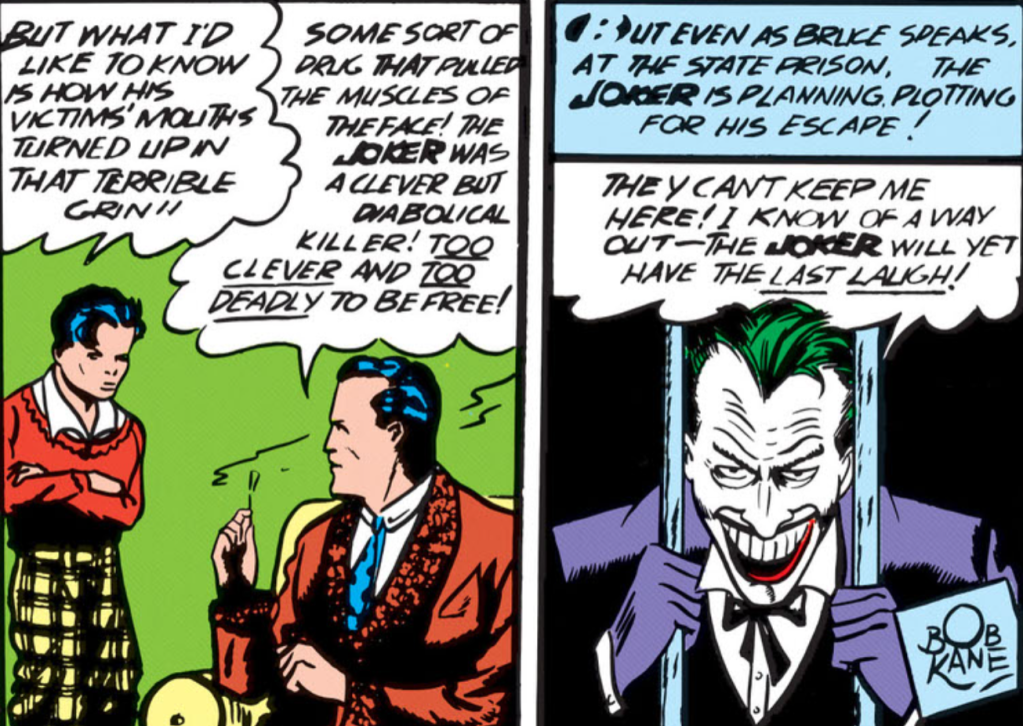
And that’s that. The Joker’s in prison! He will literally be back at the end of this issue, which is a bit of anti-climax TBH. I normally will not reproduce quite so much of a story, but this one felt not only iconic and significant, but indicative of Batman’s character caught in flux.
Next: The Return of Hugo Strange and his Monster Men!
